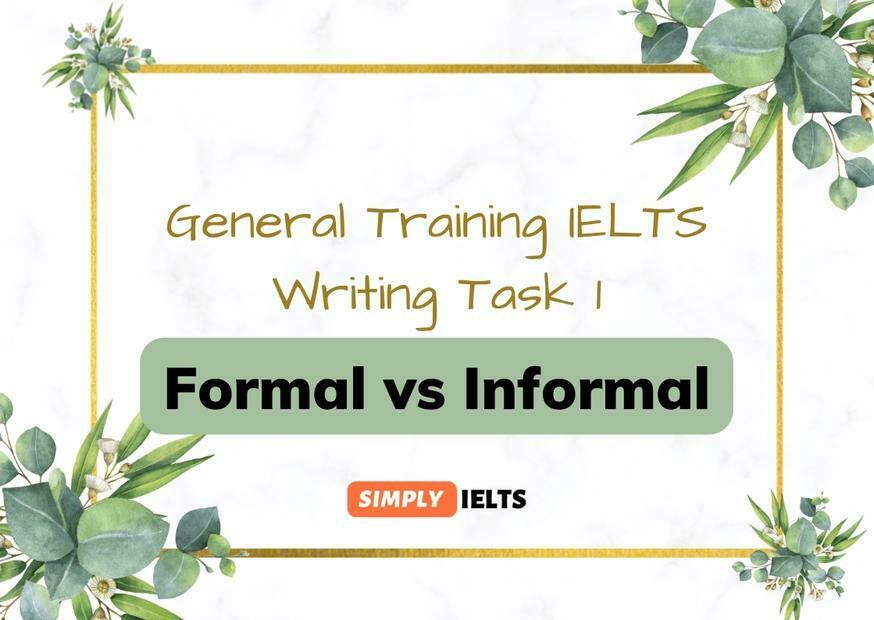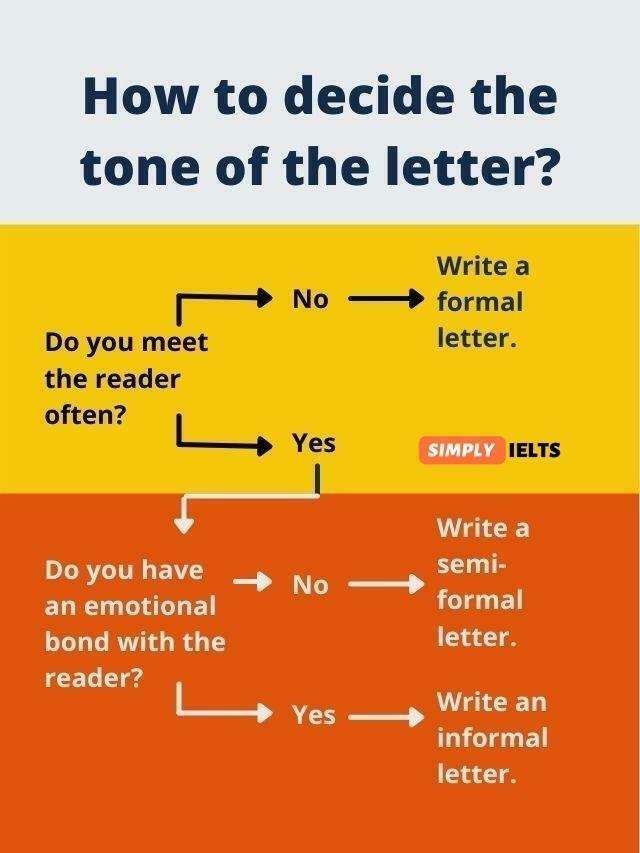How to differentiate between IELTS formal, semi-formal and informal letter
How to differentiate between IELTS formal, semi-formal and informal letter

“Hi tutor, I wrote an excellent letter just as you instructed.” My recent student was very excited after the exam.
“Great. So can I expect eight bands on writing?” said I.
“But after the exam, most students said the informal letter was easy. Now, I doubt whether I wrote the letter correctly since I approached it as a semi-formal letter.” I could sense the tension in her voice.
“Have you answered all the instructions? And have you written 170 words?”
“Yes. I have.”
“Don’t worry. You should score more than 7 for sure.”
This is a regular conversation I have with my students every now and then. Most of them do score seven bands or more. However, I notice the anxiety in their voice. In this blog, I aim to simplify how to differentiate among diverse types of IELTS letters.
To differentiate among the three types of IELTS letters that are formal, semi-formal and informal, you must pay attention to the situation and the addressee. Also, the instruction at the end of the task on how to begin the letter can be instrumental in deciding the tone of the letter.
Classification of letters based on the tone
Now, based on the situation, you can classify the letters into three main categories, namely formal letters, informal letters and semi-formal letters.
Formal Letters
Formal letters are usually the complaint letters or letters to the authority or seniors in the company. In other words, you write formal letters to unknown people. But what do you mean by an unknown? It means all those people who you rarely meet, and you have no emotional connect with them.
Informal Letters
Informal letters are written to friends and family. These are the people we meet often or at least wish to meet often, and we share an emotional bond with these people.
Semi-formal Letters
The semi-formal letters are written to the reporting manager or immediate boss or colleagues; in other words, to known people. Again, “what do I mean by known people?” I mean all those people who you meet often but do not share any emotional bonds like your friends. For example, your reporting manager or colleagues.
What if I can’t recognise the correct tone of the letter?
I would always ask you never to worry about these things since IELTS has not published any specific criteria for identifying the tone of the letter. Sometimes, based on the situation and addressee, I may think it is a semi-formal letter. In contrast, others may believe it is an informal letter. It is okay if you have followed all the instructions.
One very essential point to understand here is that the IELTS never mentions this categorisation exclusively. However, these types help us to write a letter more appropriately.
What kind of letter should write in a tricky situation like this?
Now just to explain my point further, let’s look at some of these tasks.
Let’s say you are asked to write a letter to your neighbour. Now, in most of the cultures around the world, a neighbour is supposed to be your friend, and hence, you may write an informal letter.
On the other hand, if the situation and addressee on the task dictate that you are writing the letter to a new neighbour, then some may choose to write a semi-formal letter. In this case, the student who chooses to write a semi-formal letter is not incorrect because he or she thinks that I cannot be friendly with a new neighbour.
So, different students could look at the same task from different angles.
How can I decide what should be the tone of my letter?
After reading the task, ask yourself, Do I meet this person often? If the answer is no, then you should write a formal letter, since we already know that formal letters are written to UNKNOWN people.
On the other hand, ask yourself, “Do I meet this person often?” If the answer is yes, then you should ask yourself a new question. “Do I have an emotional bond with this person?” If the answer is still yes, then you should write an informal letter. As you hopefully recall that informal letters are written to friends and family, and these are the people we often meet and even share an emotional bond with.

However, if you meet the addressee often but share no emotional bond, then you should write a semi-formal letter. As seen earlier, we write a semi-formal letter to immediate boss or colleagues, and these are the people who we meet often but don’t share an emotional bond.
Guess the tone of these IELTS letters
Now, after this discussion, let’s look at some examples that can help us to apply our discussion in real life.
Sample 1
You have already dealt with this task.
You should spend about 20 minutes on the task.
You and your family are moving to another country, and you are looking for rented accommodation there.
Write a letter to a property agent.
In your letter…
- introduce yourself, and your family
- describe the type of accommodation that you hope to find
- give your preference for the location of the accommodation
Write at least 150 words. You do NOT need to write any addresses.
Begin your letter as follows:
Dear Sir or Madam,
In this case, the situation is “You and your family are moving to another country, and you are looking for rented accommodation there.” The addressee is the property agent in some other country.
Now ask yourself, “Do I meet this person often?” The answer is NO for sure. I mean, why would you meet a property agent in some other country? For most of us, that’s impossible. Hence, you can write a formal letter on the exam. I hope you pick how to choose the tone of the letter.
Then, the first instruction is “Introduce yourself and your family”. The second instruction is “Describe the type of accommodation that you hope to find” and the last instruction is “Give your preference for the location of the accommodation”.
Instruction 4, as usual, asks you to write 150 words and not to write any addresses. And lastly, instruction 5 asks you to begin the letter with Dear Sir or Madam.
The fact that IELTS has asked you to begin the letter with Dear Sir or Madam indicates that you don’t know the name of the person. This is an additional indicator that you should write a formal letter.
Common mistake #1
Now one of the common mistakes that students commit on this task is that they mention that they wish to move from Mumbai to New Delhi. Now both these cities are in the same country.
Now with this information, you may write the whole letter, ensure significant vocabulary usage and accurate grammar. Still, you will not be able to get a maximum score since you have violated the essential task requirement.
The situation clearly mentions that you are moving to another country. If you don’t follow this fundamental request, you are bound to lose marks on IELTS.
Sample 2
Now, let’s move on to the next IELTS letter task.
You recently went on a trip with your friend, and you both took some photographs. Write a letter to your friend.
In your letter…
- Ask your friend to send you one of the photographs
- Explain why you need that particular photograph
- And tell your friend what happened to your copy of it
Write at least 150 words.
You do NOT need to write any addresses.
Begin your letter as follows
Dear _________,
In this case, the situation is “You recently went on a trip with your friend, and you both took some photographs.” The addressee is this friend of yours.
Now ask yourself, “Do I meet this person often?” The answer is YES, for sure. So, ask the next question to yourself, “Do I have any emotional bond with this person?” I mean you went on a vacation with this friend, so most probably you have an emotional connect with him or her. So, naturally, you would write an informal letter. I hope you are learning how to find the correct tone of the letter using situation and addressee.
Then, the first instruction is “ask your friend to send you one of the photographs”. The second instruction is “Explain why you need that particular photograph”, and the last instruction is “tell your friend what happened to your copy of it”.
Instruction 4, as usual, asks you to write 150 words and not to write any addresses. And lastly, instruction 5 asks you to begin the letter with Dear blank.
Common mistake #2
Now one of the common mistakes that students commit on this task is that they ask for the whole album of the photographs from the trip. But are you supposed to ask for it? No. You must only ask only for a specific photograph. Also, remember you both were taking photos and probably you had a copy of it. You should also explain what happened to your copy.
Sample 3
Now the last letter to guess.
You have decided to leave your current job even though you enjoy it.
Write a letter to inform your manager of your decision.
In your letter…
- Tell the manager about your decision and the reason for it
- Describe what you learnt in your current job
- And ask the manager to write a reference letter to help you with future employment.
Write at least 150 words.
You do NOT need to write any addresses.
Begin your letter as follows,
Dear _________,
In this case, the situation is “You have decided to leave your current job even though you enjoy it.” The addressee is your manager.
Now ask yourself, “Do I meet this person often?” The answer is YES, for sure. That’s very obvious you would always meet your reporting manager on an almost daily basis.
So, ask the next question to yourself, “Do I have any emotional bond with this person?” Now, most of the people don’t share any bond with their office colleagues or managers. So, the answer to this question is NO. Naturally, you would write a semi-formal letter.
I hope you are learning how to find the correct tone of the letter using situation and addressee.
Then, the first instruction is “tell the manager about your decision and the reason for it”. The second instruction is “Describe what you learn in your current job.”
And the last instruction is “ask your manager to write a reference letter to help you with future employment”.
Instruction 4, as usual, asks you to write 150 words and not to write any addresses. And lastly, instruction 5 asks you to begin the letter with Dear blank.
I hope you have understood how to identify the type of letter well. Now we will take one specific example for each type and try to write a letter for those examples.
Summary
After understanding the circumstances in the IELTS letter writing task and the intended reader of the letter, you can always decide the tone: formal, semi-formal or informal.
To ensure you arrive at the right answer, ask only two questions: Do I meet this person often? Would I have any emotional bond with him or her?
If the answer to both these questions is no, it is a formal letter. In case, the answer to both these questions is no, write an informal letter. Otherwise it is semi-formal letter.





Responses